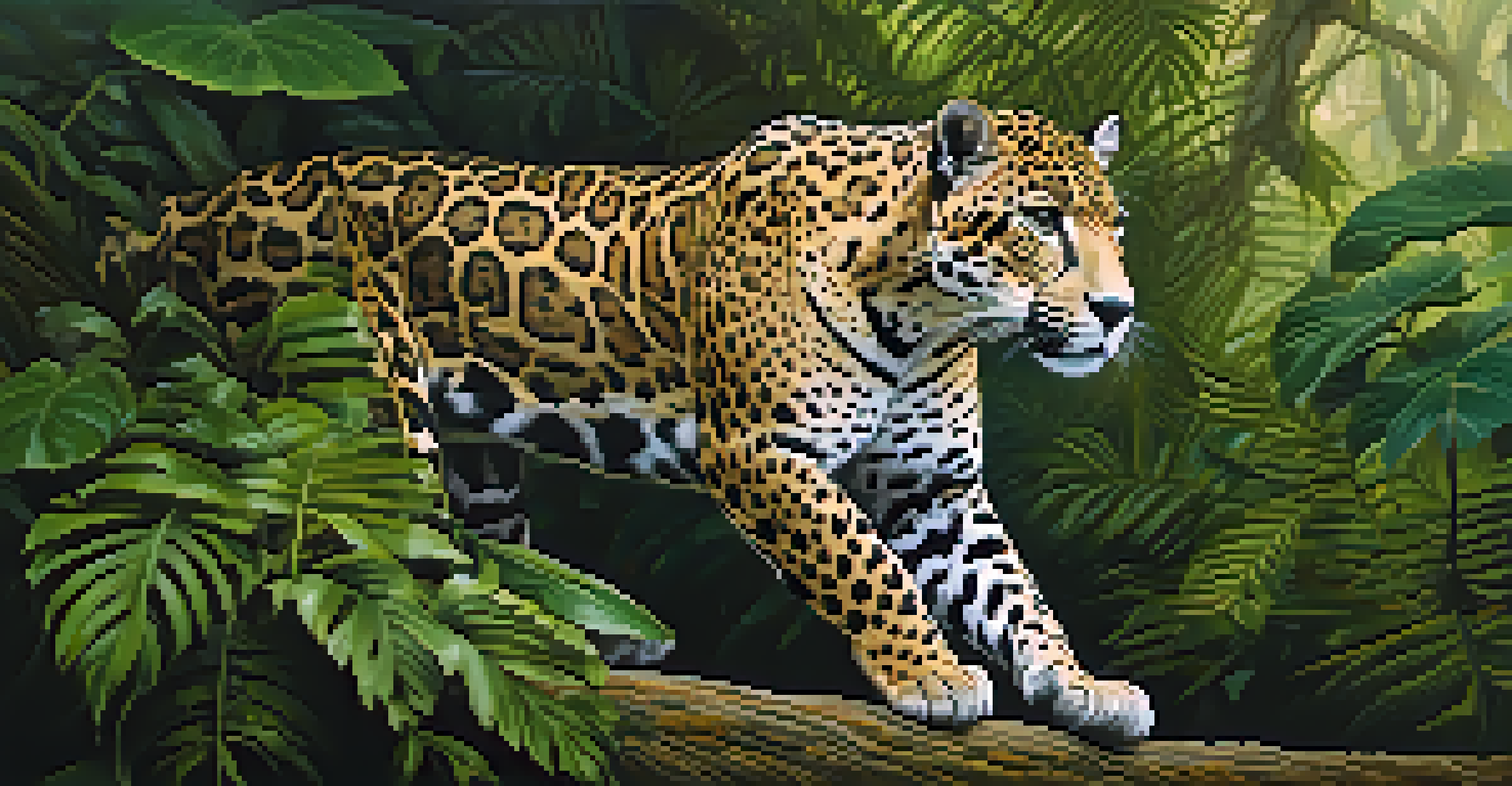Endangered Species of the Atlantic Forest: A Critical Look

Understanding the Atlantic Forest's Biodiversity
The Atlantic Forest, or Mata Atlântica, is a stunning ecosystem located along the eastern coast of Brazil, extending into Paraguay and Argentina. It is one of the most biodiverse regions in the world, home to thousands of plant and animal species, many of which are endemic. This means they are found nowhere else on the planet, making their preservation crucial not only for local ecology but for global biodiversity.
In every walk with nature one receives far more than he seeks.
Sadly, this vibrant forest has been heavily impacted by human activities such as deforestation, agriculture, and urbanization. As a result, about 70% of the forest has been lost over the past few centuries, leading to significant habitat destruction. The remaining fragments are often isolated, making it challenging for species to thrive and reproduce, which exacerbates the risk of extinction.
Understanding the Atlantic Forest's unique biodiversity is essential as it highlights the interconnectedness of life. Each species plays a vital role in maintaining the ecosystem's balance, and losing even one can have cascading effects. Therefore, the conservation of this area is not just about saving individual species but preserving a whole web of life.
Key Endangered Species in the Atlantic Forest
Several species are critically endangered within the Atlantic Forest, including the golden lion tamarin, the jaguar, and the Atlantic Forest tree frog. The golden lion tamarin, with its striking orange fur, is a prime example of a species that has suffered greatly due to habitat loss. Conservation efforts have been implemented to protect these small primates, but their future remains precarious as their habitat continues to dwindle.

The jaguar, known for its powerful presence and stealth, is another species facing dire threats in the Atlantic Forest. As the top predator, the jaguar plays a crucial role in maintaining the health of the ecosystem. However, poaching and habitat fragmentation have significantly reduced its population, highlighting the urgent need for protective measures.
High Biodiversity at Risk
The Atlantic Forest is one of the most biodiverse regions globally, but it faces severe threats from deforestation and habitat loss.
Lastly, the Atlantic Forest tree frog is an example of a lesser-known species at risk. This frog, with its vibrant colors, is sensitive to environmental changes, making it a bioindicator of the forest's health. As climate change and pollution affect its habitat, the plight of this species underscores the broader challenges facing the entire ecosystem.
The Impact of Deforestation on Species Survival
Deforestation is one of the most significant threats to the species of the Atlantic Forest. As trees are cut down for agriculture, logging, and urban development, the natural habitats of many animals and plants are destroyed. This not only leads to the immediate loss of trees but also disrupts the delicate balance of the ecosystem, making it harder for remaining species to find food, shelter, and mates.
The Earth does not belong to us: we belong to the Earth.
Moreover, the fragmentation caused by deforestation isolates populations, making it difficult for them to interbreed. This is particularly concerning for species with small populations, as inbreeding can lead to a decline in genetic diversity, making them more susceptible to diseases and reducing their adaptability to changing environmental conditions. Without genetic diversity, species are much less likely to survive in the long term.
In addition to the direct loss of habitat, deforestation also contributes to climate change, which poses further risks to the Atlantic Forest's biodiversity. As the forest is cleared, carbon stored in trees is released into the atmosphere, exacerbating global warming. This creates a vicious cycle where climate change further threatens the delicate ecosystems that remain.
Conservation Efforts in the Atlantic Forest
Conservation efforts in the Atlantic Forest have gained momentum in recent years, with various organizations and governments working together to protect this vital ecosystem. One successful initiative is the establishment of protected areas, which are designated zones where human activity is limited, allowing wildlife to thrive. These protected areas are crucial for maintaining biodiversity and providing safe havens for endangered species.
In addition to protected areas, reforestation projects are taking root, aiming to restore degraded landscapes. By planting native trees and regenerating habitats, these initiatives not only benefit wildlife but also help to capture carbon, combatting climate change. Community involvement in these projects is critical, as local residents often play a pivotal role in the restoration and stewardship of their natural surroundings.
Endangered Species Abound
Several species, including the golden lion tamarin and jaguar, are critically endangered due to habitat destruction and climate change.
Education and awareness campaigns are also essential components of conservation efforts. By engaging communities and raising awareness about the importance of the Atlantic Forest, these initiatives encourage sustainable practices that benefit both people and wildlife. When communities understand the value of their natural resources, they are more likely to take action to protect them.
The Role of Local Communities in Conservation
Local communities are vital in the fight to protect endangered species in the Atlantic Forest. Their knowledge of the land and its resources enables them to manage and conserve local ecosystems effectively. By involving communities in decision-making processes, conservation efforts are more likely to succeed, as they take into account local needs and traditions.
Furthermore, many community members rely on the forest for their livelihoods, whether through sustainable agriculture, ecotourism, or traditional practices. When local people are empowered to participate in conservation, they can create sustainable economic opportunities that complement environmental preservation. This leads to a win-win situation where both nature and communities thrive.
Programs that promote sustainable practices, such as agroforestry and responsible tourism, can also foster a sense of stewardship among community members. When people see the tangible benefits of conservation—like improved soil health or increased wildlife sightings—they are more likely to support and engage in these efforts. Ultimately, the success of conservation initiatives in the Atlantic Forest hinges on the active involvement of its local communities.
The Impact of Climate Change on the Atlantic Forest
Climate change poses significant threats to the Atlantic Forest and its endangered species. Rising temperatures, changing rainfall patterns, and more frequent extreme weather events can disrupt the delicate balance of this ecosystem. Many species may struggle to adapt to these rapid changes, leading to shifts in their populations and distributions.
For instance, some plant species may find it increasingly difficult to survive in their native habitats, leading to potential declines in populations. This can have a cascading effect on the entire food web, as animals that rely on these plants for food may also face challenges. The interconnectedness of life in the Atlantic Forest means that climate change can impact not just individual species, but entire ecosystems.
Community Involvement is Crucial
Local communities play a vital role in conservation efforts, as their engagement leads to sustainable practices that benefit both the environment and their livelihoods.
Moreover, climate change can exacerbate existing threats, such as deforestation and habitat fragmentation. As conditions become less favorable for certain species, human encroachment may increase as people search for alternative resources or land for agriculture. This underscores the urgency of addressing climate change as part of the broader conservation strategy for the Atlantic Forest.
How You Can Help Protect Endangered Species
Everyone has a role to play in protecting the endangered species of the Atlantic Forest, even if you live far away from this rich ecosystem. One of the simplest ways to make a difference is by supporting conservation organizations that work to protect these habitats. Donations, volunteering, or spreading the word can amplify the efforts of those on the ground.
Additionally, making conscious consumer choices can significantly impact the health of the Atlantic Forest. Opting for sustainably sourced products, such as timber and paper, reduces the demand for goods that contribute to deforestation. Each time you choose products that support sustainable practices, you're helping preserve the forest and its inhabitants.

Lastly, raising awareness about the plight of the Atlantic Forest and its species can inspire others to take action. Share information on social media, participate in local conservation initiatives, or simply have conversations with friends and family. Every small action contributes to a larger movement toward saving this invaluable ecosystem and the extraordinary species that call it home.